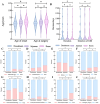Unraveling the site-specific features in small intestinal stromal tumors: a retrospective study
- PMID: 40335936
- PMCID: PMC12057284
- DOI: 10.1186/s12876-025-03945-5
Unraveling the site-specific features in small intestinal stromal tumors: a retrospective study
Abstract
Background: Gastrointestinal stromal tumors (GISTs) are a rare and less well-characterized disease. There is limited information on the clinical features of small intestinal GISTs at different sites.
Aims: To enhance the understanding of the clinical characteristics and disease behavior of small intestinal GISTs based on their sites.
Methods: We conducted a retrospective review of medical records for 317 patients diagnosed with primary small intestinal GISTs confirmed by surgical pathology, comparing their clinical features and tumor characteristics.
Results: According to this cohort's data, duodenal GISTs presented with longer disease durations and higher prevalence of melena (44.6%), while jejunal GISTs manifested as abdominal masses (11.5%) and acute gastrointestinal bleeding (GIB) (13.3%), with the highest rate of emergency surgeries (16.8%). Ileal GISTs were associated with an older age of onset and a higher prevalence of hematochezia (19.6%), with one-third of cases discovered incidentally during gynecological procedures. Notably, the biological behavior of small intestinal GISTs varied significantly by sites. Tumors demonstrated different immunochemical markers and a progressive increase in diameter, mitotic activity, T and M stages, and risk classification from the duodenum to the jejunum and ileum. These findings warrant further validation in prospective multicenter studies.
Conclusions: Small intestinal GISTs might exhibit distinct clinical presentations and oncological features depending on their sites.
Keywords: Biological behavior; Clinical features; Gastrointestinal bleeding; Risk category; Small intestinal stromal tumors.
© 2025. The Author(s).
Conflict of interest statement
Declarations. Ethics approval and consent to participate: This manuscript’s analyses are strictly derived from de-identified clinical data systematically extracted from the Hospital Information System (HIS). The retrospective study protocol was reviewed and approved by the Institutional Review Board (IRB) of the Peking Union Medical College Hospital (PUMCH) (No. I-22PJ407), including a waiver of written informed consent. The study protocol also incorporated telephone follow-ups, which needs verbal consent acquisition according to IRB. But this manuscript does not involve any results from telephone follow-ups. This study was in compliance with the Helsinki Declaration. Consent for publication: Not applicable. Competing interests: The authors declare no competing interests.
Figures


Similar articles
-
Gastrointestinal Bleeding Due to Gastrointestinal Tract Malignancy: Natural History, Management, and Outcomes.Dig Dis Sci. 2017 Feb;62(2):491-501. doi: 10.1007/s10620-016-4368-y. Epub 2016 Dec 28. Dig Dis Sci. 2017. PMID: 28032204
-
Clinicopathological Features and Prognosis of Gastrointestinal Stromal Tumor Located in the Jejunum and Ileum.Dig Surg. 2019;36(2):153-157. doi: 10.1159/000487147. Epub 2018 Apr 26. Dig Surg. 2019. PMID: 29698938
-
Gastrointestinal stromal tumor of the small intestine: a clinicopathologic study of 70 cases in the postimatinib era.World J Surg. 2009 Apr;33(4):828-34. doi: 10.1007/s00268-009-9918-4. World J Surg. 2009. PMID: 19198935
-
Large duodenal gastrointestinal stromal tumor presenting with acute bleeding managed by a whipple resection. A review of surgical options and the prognostic indicators of outcome.JOP. 2011 Mar 9;12(2):194-9. JOP. 2011. PMID: 21386652 Review.
-
Gastrointestinal stromal tumor of the duodenum presenting with shock and massive upper and lower gastrointestinal bleeding: a case report and review of the literature.J Med Case Rep. 2024 Jun 22;18(1):286. doi: 10.1186/s13256-024-04597-x. J Med Case Rep. 2024. PMID: 38907357 Free PMC article. Review.
References
-
- Blay JY, Kang YK, Nishida T, von Mehren M. Gastrointestinal stromal tumours. Nat Rev Dis Primers. 2021;7(1):22. - PubMed
-
- Søreide K, Sandvik OM, Søreide JA, Giljaca V, Jureckova A, Bulusu VR. Global epidemiology of Gastrointestinal stromal tumours (GIST): A systematic review of population-based cohort studies. Cancer Epidemiol. 2016;40:39–46. - PubMed
-
- Wang ZH, Liang XB, Wang Y, Ma GL, Qu YQ, Tian XW. [Epidemiology survey of Gastrointestinal stromal tumor in Shanxi Province in 2011]. Zhonghua Yi Xue Za Zhi. 2013;93(32):2541–4. - PubMed
MeSH terms
Grants and funding
- 2021-I2M-1- 003/Chinese Academy of Medical Sciences (CAMS) Innovation Fund for Medical Sciences
- 2021-I2M-1- 003/Chinese Academy of Medical Sciences (CAMS) Innovation Fund for Medical Sciences
- 2022-PUMCH-B-022/National High-level Hospital Clinical Research Funding
- 2022-PUMCH-B-022/National High-level Hospital Clinical Research Funding
LinkOut - more resources
Full Text Sources
Medical

